Most radiant heating systems operate using warm water. It is not very hard to heat water. Here are only some of your many choices for heating energy sources: natural gas, propane (LP), oil, coal, wood, electricity, heat pumps, ground source heat pumps and solar energy. Radiantec strives to offer products that are highly energy efficient and yet still a smart investment.
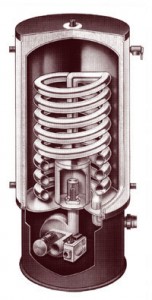
The Polaris Water Heater
Gas Fired Water Heater
Here at Radiantec we often recommend the use of domestic water heaters instead of expensive boilers. Click here for more information about how using a hot water heater instead of a boiler is both energy efficient & saves you money.
Gas is readily available and is produced mostly within the United States. The price of gas has risen along with other sources but it is clean enough to use with condensing flue gas technology.
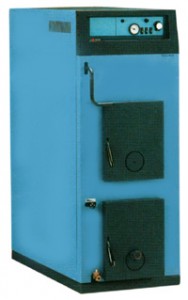
A quality wood fired boiler
Oil Fired Boilers or Water Heaters
Oil can be less expensive than gas in some locations at this time. Oil also has more heat value than liquified gas (LP). However, oil has a number of drawbacks. Oil pollutes more than gas and the heating units are not as efficient at this time. We are not aware of oil fired units that can condense the flue gas, but some are in the developmental stages.
Further, many of our oil supplies are imports that come from unstable countries. The price and availability of heating oil can be unstable for political reasons. Finally, some folks believe that our oil resources should be reserved for transportation.
Wood or Coal Heaters
These heaters work best when they are allowed to have a prolonged burn time at reasonably high temperatures.
Unfortunately, wood and especially coal heaters can seriously pollute when they are shut down with a load of fuel remaining. If you choose to go with this heating energy source we recommend you incorporate some kind of heat storage into the system so that the heater can be operated at convenient times and with lower emissions. A storage system similar to that of a solar heating system works very well for this purpose.
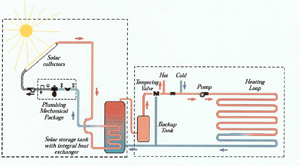 The graphic to the right illustrates a popular solar heating system that makes domestic hot water as well as space heat. If you use a wood boiler instead of solar panels, you will have a wood heating system with many advantages. You will make domestic hot water and have the benefits of thermal storage. We also think that the overall system will be safer. Wood or coal can provide energy independence and can be cost effective if you value labor as healthful exercise. But it is very important to burn these products cleanly.
The graphic to the right illustrates a popular solar heating system that makes domestic hot water as well as space heat. If you use a wood boiler instead of solar panels, you will have a wood heating system with many advantages. You will make domestic hot water and have the benefits of thermal storage. We also think that the overall system will be safer. Wood or coal can provide energy independence and can be cost effective if you value labor as healthful exercise. But it is very important to burn these products cleanly.
Solar Collectors
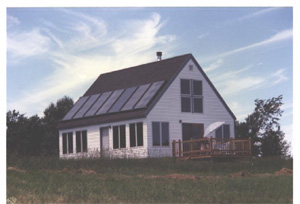 It is easy for solar collectors to make warm water. The relatively low temperatures required by radiant systems allow for good efficiency at the solar panel. The quality and efficiency of solar heating has improved greatly and the investment value or “payback” can be very good when the system is well designed.
It is easy for solar collectors to make warm water. The relatively low temperatures required by radiant systems allow for good efficiency at the solar panel. The quality and efficiency of solar heating has improved greatly and the investment value or “payback” can be very good when the system is well designed.
Nearly all solar heating systems require some way to store the heat for times when the sun isn’t shining. Slab on grade construction is ideal for this purpose. Domestic hot water heaters can also be used to store solar heated water for later use.
In almost all cases, a solar energy system will require some form of “backup” to provide heat over long cloudy periods. Otherwise, you will hit a point of diminishing returns overdesigning your system in an attempt to go 100% solar.
You can either “do a little solar”, and use two or three solar collectors or, if architecture permits, you can use more solar collectors to push for a higher solar heating percentage of your heat and hot water. Either way, it is a mistake to “overdo” a solar system. You can create architectural problems if you try to squeeze too many solar panels on your roof.
Bear in mind that solar panels made for heating water contain a network of tubing filled with water, so they weigh significantly more than photovoltaic solar panels intended to convert electricity from the sun.
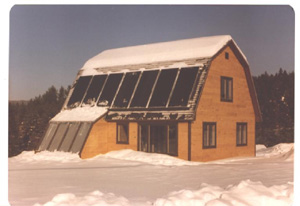
Solar collectors do not have to be placed upon the house. They can also be mounted on a stand at ground level.
Photovoltaic solar collectors that make electricity are coming down in price.
Depending upon climate, architecture, and commitment, solar heating contributions vary from 25% to 95%. Solar Section
Radiant Retrofit
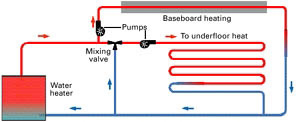
You can add on to a boiler that you already have for baseboard heating. You will need a mixing valve to be able to lower the high temperature boiler water to a temperature safe for your radiant heat system while still providing the high temperature boiler water to perform the uses that the boiler was designed for.
It may be desirable to use oxygen diffusion barrier tubing in order to protect system components. An alternative would be to separate the two fluids with a heat exchanger.
Electric Heat
Electric heating is not very desirable unless a low cost source of electricity is available with low environmental impacts such as hydro or solar. In some cases when only a very little electricity is needed, an electric heat source can make sense.
Electricity is expensive to generate and usually has great environmental impacts.
Most electricity in the United States is generated either with coal, or nuclear, or fossil fuels. Energy efficiency for electricity is not high because of the losses from energy conversion and also from line losses in transmission.
Using electricity for simple purposes like heating and hot water is to be avoided.
Geothermal
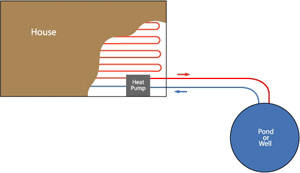
So-called geothermal energy sources extract heat energy from the ground with an electric heat pump. The problems are that parasitic electrical costs are usually very high and the purchase price of the system is quite expensive as well.
In a way, the environmental costs of a geothermal system are nearly as high as a straight electrical system and there is no real cost saving when everything is added up.
If the “COP” or “coefficient of performance” can be improved and costs can be lowered this approach might make a real contribution, but the numbers are not there yet.
CAUTION:
Some heating units require an unreasonable amount of pumping energy to move water through the unit. It would be a shame to buy two high-head pumps and then forever listen to the noise that they make and also pay for the electricity that they use. Modulating gas units are particularly subject to this problem.
